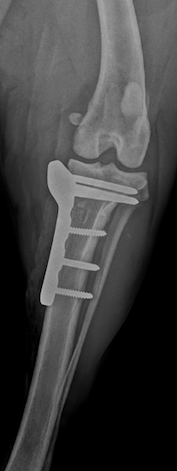Pickle the Labrador had spent the morning watching his owner packing for her once-in-a-lifetime trip to go on horseback safari in Africa. He was pretty excited when she decided to take a break from packing and go for a walk on the beach. Minutes later, 11-year old Pickle was being given the run-around by 2-year old Saffie, but holding his own until he suddenly had a painful right hindlimb. Jenna (his owner) panicked as she was due to fly out in only 5-days’ time. She brought Pickle straight over to our Modbury surgery where he was examined and had x-rays taken of his stifles (knees). Our vet Lucy diagnosed a ruptured cruciate ligament.

Cruciate ligament rupture is a common problem in dogs and especially in Labradors. The ligament slowly degenerates over time and then finally snaps during exercise, as with Pickle on the beach. When the ligament ruptures the stifle/knee becomes unstable and weightbearing becomes difficult for the dog. Most dogs need surgery to return stability to the stifle joint: Jenna was really worried about going on holiday while Pickle was nursing an injury. By coincidence, the safari trip was actually planned to celebrate the 40th birthday of Jenna’s best friend Ellie, who happens to be my wife! The pressure was on for me to sort Pickle out and save the trip having to be delayed or cancelled. Luckily the nurses at Ivybridge were very understanding of the situation and allowed me to squeeze in an extra surgery the very next day. I promised to supply snacks as a thank you!
Pickle had a TPLO surgery performed the next day which went well. This involves cutting a circular section off the top of the tibia (shin bone) and rotating it to flatten the joint surface – this stabilises the joint when weightbearing and stops the discomfort caused by cruciate ligament rupture. The cut section of bone is held in its new position with a metal plate and screws until it heals – this takes 2-3 months in total. Jenna had been a little worried that Pickle’s age would count against him, but I reassured her that I have performed cruciate surgery in many dogs of a similar age and their outcomes are almost identical to that of younger dogs. Once the 2-3 month recovery period is over, most dogs return to full function, running on the beach, jumping onto the sofa (if allowed!) and having normal levels of exercise. I haven’t yet had an owner of an older dog regret going ahead with the surgery.
From Pickle going lame on the beach to returning home after successful surgery was just over 48 hours. We have designed South Moor Vets so that we can offer diagnosis and treatment of the vast majority of conditions within the practice we have multiple ‘RCVS recognised advanced practitioners’ and certificate holders in various disciplines as well as all the diagnostic and surgical equipment required so that we don’t have to refer clients to distant specialist centres very often. Although we are busy, we will always try to be flexible when a client’s circumstances require. Fortunately, in Pickle’s case that meant that Jenna and Ellie didn’t have to cancel their safari trip, we weren’t jealous at all!





Comments
This article has no comments yet. Be the first to leave a comment.